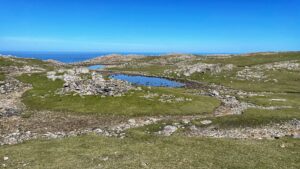Scotland’s peninsulas tend to be windswept, remote, and stubbornly overlooked. Àird Uig is no exception. At its northern tip sits the headland of An Gallan Uigeach, its western cliffs taking the full brunt of the Atlantic.
This was the daily view for a handful of Irish monks who, sometime after the mid-sixth century and before the Vikings came calling, chose this place to test their faith through hardship and isolation. Their lives were a kind of living martyrdom, endured on a barren edge of the known world.

Near a small loch, on a cliffside promontory, lie the ruins of a drystone chapel named “Taigh a’ Bheannaich”—the Blessing House. Around it, they say, are the faint traces of ten to twelve hut-like dwellings, each barely a few metres wide. I say “they say” because the remains are elusive, and time has not been kind. Still, there are worse ways to spend half an hour than squinting at stones, wondering if these ones or those were once someone’s shelter1Canmore ID 4030 Permalink http://canmore.org.uk/site/40302Canmore ID 4026 Permalink http://canmore.org.uk/site/4026.
The chapel itself is easier to spot. Rectangular, several stones high, it clings to a flat rocky knoll, hemmed in by dried-up streams and lochans. It has faced the Atlantic for nearly 1,400 years. One wonders what faith it took to build it here—and what silence must have followed.
- 1
- 2
